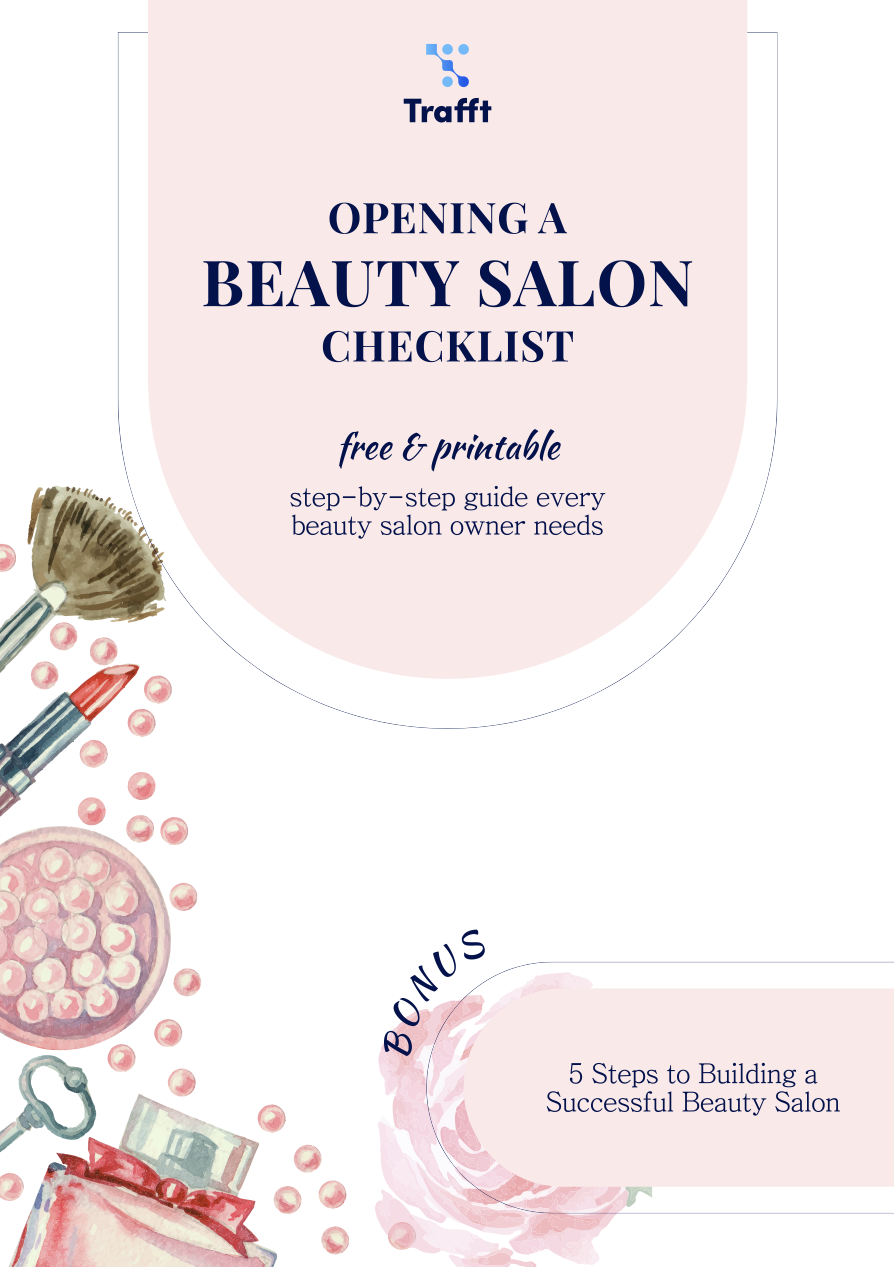A commission-based salon is a popular business model in the beauty industry since it offers benefits for both salon owners and stylists.
For salon owners, commission-based business models offer a scalable and motivating system where stylists are encouraged to attract and retain clients. For stylists, it offers a potential for higher earnings compared to hourly wages. This approach fosters growth and innovation, but let’s see how to successfully run a commission-based salon.
Thank you for subscribing. Check your mail for details
What is a Commission-Based Salon?
This is a business model where stylists earn a percentage of the income generated from the services they provide. Instead of receiving hourly wages, stylists’ earnings are directly tied to the value of services they deliver. The commission-based model encourages stylists to perform at their best and share profits with salon owners.
In this scenario, the salon owner provides the workspace, tools, products, and marketing, while stylists are focused on serving clients. The commission rate can vary, but usually, it ranges from 40% to 60%, depending on factors like stylist experience, service type, and salon location.
How do commissions work in a salon setting?
Commissions are usually calculated as a percentage of the revenue from each service a stylist performs. For example, if a client is charged $100 for a haircut, and the stylist’s commission rate is 50%, they will earn $50, and the remaining $50 goes to the salon.
Some salons may include additional commission incentives for upselling products or premium services, which further encourages stylists to maximize their contribution.
What are the advantages of commission-based systems?
First off, if you choose a commission-based model, you will encourage your stylists to do their best. Since they are directly rewarded for their effort and skill, stylists will be encouraged to work harder, improve their techniques, and build strong client relationships.
Secondly, this system helps you align the salon's goals with your employees’ goals. Since their income depends on the salon’s revenue, their goals will naturally align with the overall success of the business.
What challenges might you face?
The most common challenge commission-based salons might face is ensuring the commission rates are competitive and equitable, especially when you’re managing a team with varying skill levels and experience. The key is to have clear communication and transparency with your employees to avoid conflicts.
Secondly, you must balance expenses and profits. While this system encourages stylists, you must ensure the structure is financially sustainable. Too high compensation rates can strain your salon’s ability to cover overhead costs, while low rates may demotivate your employees.

How to Run a Commission-Based Salon?
To achieve a successful commission-based salon, you first need to thoughtfully plan and structure the foundation. Here’s how you should do it:
Determine the commission structure
Stylists should earn a percentage of the revenue they generate. Common commission rates range between 40% and 60%.
Entry-level stylists may start at around 40-50% to reflect their experience and skill levels. More experienced stylists can earn 50-60% or more, especially if they have an established client base or offer high-value services. Be thoughtful about the percentage rates, since it should balance motivating your stylists while leaving enough revenue to cover salon expenses.
What factors influence commission rates?
- Experience: Experienced stylists often command higher rates due to their skills and ability to attract clients.
- Service type: High-end services like hair extensions may require higher commission rates compared to basic cuts or trims.
- Location: Salons in competitive markets or premium locations might offer higher rates to attract top talent.
- Overhead: Costs like rent, utilities, and products are also important when setting rates.
How to calculate commissions?
The calculation is simple but must be accurate. Here’s the formula:
Service price × Commission rate in % = Stylist commission
For example, if a service costs $80 with a 60% commission rate, the stylist earns:
$80 × 60% = $48
This means the stylist receives $48, while the salon retains the remaining $32.
Establish clear policies
Clear and transparent policies will ensure smooth operations and communication with your employees. These policies ensure fairness, avoid confusion, and foster trust between salon and stylists.
Payment schedules
A consistent payment schedule is crucial, common options include:
- Weekly payments: A popular choice for ensuring stylists receive their earnings on time. It helps them manage professional finances effectively, especially in high-turnover environments.
- Bi-weekly payments: Offers a balance between timely payments and administrative efficiency for the salon
Regardless of the frequency, provide detailed pay statements showing:
- The service performed
- Total revenue generated
- Commissions earned
- Any additional bonuses or deductions
Client ownership and retention policies
Defining client ownership is crucial for avoiding conflicts when stylists leave, and for maintaining business continuity.
- Salon ownership model: In this model, the salon retains ownership of the clients. Their contact details and records are maintained by the salon, ensuring the business relationship remains intact if a stylist departs.
- Hybrid model: Stylists may bring in their own clients but agree that new clients acquired while working at the salon belong to the business.

Image by macrovector on Freepik
Handling product and service upselling commissions
Upselling products and premium services benefit both the salon and the employees. You should think about implementing a system that rewards your employees for their contributions:
- Product sales business: Offer a fixed bonus or an additional commission percentage for each product sold. For example, a 10% commission on retail products encourages stylists to promote them.
- Service upselling rewards: Encourage stylists to recommend higher-value services, such as conditioning treatments, color upgrades, or add-ons, by offering a percentage of the upsell revenue.
Legal and financial considerations
Legal and financial aspects are one of the most important things when running a commission-based salon. They will protect your business and ensure smooth operations. Keep this in mind:
Employment vs. independent contractor classification
Think about whether your stylists will be classified as employees or independent contractors. Each classification has distinct legal and financial implications:
Employees:
- Stylists work under your supervision, follow a set schedule, and use salon-provided tools and products.
- As employees, they are entitled to benefits such as minimum wage, overtime pay, and potentially health insurance, depending on local laws.
- You are responsible for withholding and paying employment taxes, such as Social Security, Medicare, and unemployment insurance.
Independent contractors:
- Stylists operate as self-employed individuals, often renting a chair or workspace from your salon.
- They manage their own schedules, provide their own tools, and are responsible for paying their tax.
- While this model can reduce administrative burdens, misclassifying employees as contractors can lead to legal and financial penalties.
Compliance with labor laws and tax obligations
To avoid fines, lawsuits, or disruptions in your business, you must stay compliant with labor laws. Here’s what to focus on:
Research local and federal laws:
- Research wage laws, overtime policies, and employee benefits requirements.
- Understand rules regarding breaks, sick leave, and holidays for employees.
Register your business properly:
- Obtain the necessary permits and licenses to operate a salon in your jurisdiction,
- Set up tax accounts with federal and local agencies to report stylist earnings accurately
Record keeping and reporting:
- Keep a detailed record of stylist payments, including commissions, bonuses, and tax withholdings.
- Use payroll software or hire a professional to ensure accurate reporting of taxes and compliance with regulations.
Pro tip: Consult an accountant or employment lawyer to review your practices and confirm compliance with labor laws and tax codes.
Contracts and agreements
Contracts are very important for defining the relationship between you and your stylists, and for preventing misunderstandings or disputes. A strong agreement should include:
Commission terms:
- Specify commission rates, payment schedules, and any conditions for bonuses or upselling rewards.
- Outline how changes to the commission structure will be communicated and implemented.
Client ownership and non-solicitation clauses:
- Define whether clients belong to your salon or the stylist,
- Include a non-solicitation clause to prevent stylists from taking clients with them if they leave.
Roles and responsibilities:
- Clearly describe expectations for the stylist, such as adhering to salon policies, maintaining professionalism, and following hygiene standards,
- Specify whether the stylist is responsible for providing their own tools, or if these are provided by the salon.
Termination policies:
- Outline processes for ending the relationship, including notice periods, final payments, and the handling of client records.
Pro tip: Have all contracts reviewed by a legal professional to ensure they comply with labor laws and protect both parties’ interests.
Tips for Long-Term Success of Your Commission-Based Salon
#1 Adapt to industry trends
Offer training services, invest in stylist training, and leverage technology like salon scheduling software to stay competitive. Keeping up with industry innovations and giving opportunities to clients to book online at their own convenience will enhance customer satisfaction and streamline operations.
Handle commissions and bookings with ease in your salon!
Save time and simplify your workflow - manage bookings and commissions with Trafft!
With Trafft, you can automatically calculate employee commissions without manual effort, choose between fixed and variable commissions, and set custom commission rates.
But that's not all!
Trafft is a perfect choice for automating bookings and simplifying administrations. From a dedicated booking page, clients can book at any time of the day or night, so you’ll be available for bookings 24/7!
They can pay online through popular gateways such as PayPal, Mollie, Stripe, Authorize.Net, and Square. Trafft sends automated notifications through email, SMS, and WhatsApp about their upcoming bookings, booking confirmations, or cancelations, so you never again come across no-shows or disruptions in schedule.
Sign up for FREE or give Trafft a test run and revolutionize how you manage your salon!
#2 Regularly review commission rates
Periodically adjust commission rates to stay competitive and reward performance. Consider tiered structures for high achievers and align rates with salon growth to keep stylists motivated and loyal.
#3 Maintain open communication with staff
Hold regular team meetings and one-on-one check-ins to address concerns, share updates, and recognize achievements. Transparency about changes builds trust and fosters a positive work environment.
Closing Thoughts on How to Run a Commission-Based Salon
This system can be really rewarding for both stylists and the salon if you set it right. A fair commission structure, clear policies, and legal and financial considerations will help you create a strong foundation for success.
Whether you’re just starting or looking to refine your current setup, implementing these strategies will help you build a successful and sustainable salon business!
Don’t forget to read:
- How Much Do Salon Owners Make in 2025? + Tips to Earn More
- Top 8 Mistakes to Avoid as a Salon Owner
- Salon Loyalty Programs That Work: Tips to Keep Your Clients Loyal







